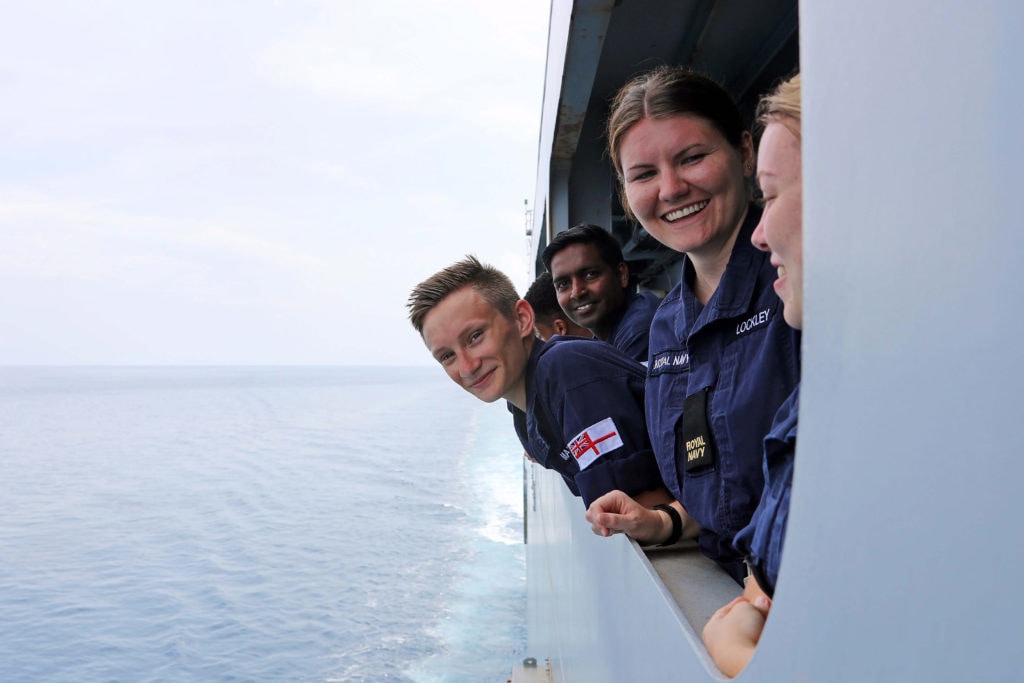Huge spike in applications to join Royal Navy
 ** Best of Defence Imagery 2018 **
Image of Royal Navy personnel at sea on HMS Albion, anticipating the arrival of a French Task Group.
Today (21-04-2018) HMS Albion met the French Task Group operating in the Far East, The Assault Ship FS Dixmude (L9015) and the Frigate FS Surcouf (F711).
The three ships took the opportunity to exchange elements of their crews for a few hours so they could gain an insight into how other nations operate.
Whilst the units were together they conducted Officer of the Watch Manoeuvres and the two Royal Navy Wildcat helicopters from 847 NAS, currently embarked on FS Dixmude took to the skies to requalify Albion in deck landing and to conduct a Photex.
The Fleet Flagship is one of three Royal Navy warships deploying to the Asia-Pacific in 2018 to work alongside the UK’s friends and allies to promote peace, security and prosperity in the region.
** Best of Defence Imagery 2018 **
Image of Royal Navy personnel at sea on HMS Albion, anticipating the arrival of a French Task Group.
Today (21-04-2018) HMS Albion met the French Task Group operating in the Far East, The Assault Ship FS Dixmude (L9015) and the Frigate FS Surcouf (F711).
The three ships took the opportunity to exchange elements of their crews for a few hours so they could gain an insight into how other nations operate.
Whilst the units were together they conducted Officer of the Watch Manoeuvres and the two Royal Navy Wildcat helicopters from 847 NAS, currently embarked on FS Dixmude took to the skies to requalify Albion in deck landing and to conduct a Photex.
The Fleet Flagship is one of three Royal Navy warships deploying to the Asia-Pacific in 2018 to work alongside the UK’s friends and allies to promote peace, security and prosperity in the region.
The Royal Navy is currently enjoying a 30% uplift in recruitment applications due to Covid-19. As life choices for young adults shrink across the globe, with travel curtailed, and employment opportunities shrinking, stable employers with an air of certainty are suddenly more attractive. And these numbers look likely to increase with Alexander Boris de Pfeffel Johnson’s agreement to a four-year £16.5bn surge in defence spending announced this week.
“It’s a really good yield, we hope it’ll continue,” says Captain Pete Viney, responsible for naval recruiting.
According to Viney, most applications are from 18-24 year olds. The Royal Navy recruitment uptick includes those looking at the marines, reserves and the Royal Fleet Auxiliary. He says that this year, the Royal Navy is really close to achieving 100% of its recruitment target.
The only problem for those looking to sign-up is that the navy wasn’t down by 30% last year, so there isn’t quite enough space for them all.
Viney advises that those applying should be ‘open minded’ and consider ‘specialist’ roles across all the branches. The specialist roles offer apprenticeships – a move in language away from ratings – and also come with solid qualifications at the end of training. He says that there are many opportunities to be seized, even if they overall numbers for specialist applications across the piece are up by 28%.
Those seeking direct entry as an officer are up by 34%. Viney notes that some branches are more popular than others.
“We’re overwhelmed with applications to be a pilot in the Royal Navy. But not everyone is able to fly a jet,” he says.
Like many organisations, the navy has had to adapt its working practices. While Viney says Covid-19 hasn’t affected the ability to recruit, it has had a slight effect on training capacity.
“We haven’t stopped training or recruiting for a moment,” he says. “It’s had its challenges but we’ve kept going. We thought on our feet about keeping recruiting and training going.”
One adaption has allowed the AIB (a two-day intensive Admiralty Interview Board) to “break free after many decades of doing things the same way”, and embrace technology to develop its processes. It’s been refined with the onus changed to suit the online circumstances.
“We came up with it in 72 hours and are refining it now,” Viney says. “In six to nine months it will be refined again from where we are at now.”
Another development is that HMS Collingwood will take basic recruits for first time ever from Jan 2021. Traditionally they’re trained at HMS Raleigh.
Viney says he’s “dreading the new Top Gun film coming out,” as this will see an influx of applications to be Tom Cruise, but in the meantime, there are lots of opportunities for submariners.
“Getting people to consider the submarine service is difficult,” he says. “But they’re big, modern and high tech. Half of the people who actually visit one volunteer.”












If you have A Levels or more than a handful of GCSEs do not join as a rating or apprentice as they seem to be calling them now. Ask yourself how many of these recruits went to private schools, then compare to those gaining a commission. Eight years of my life lost cleaning toilets and showers, painting ships’ sides and polishing officers’ lino.
HMS Collingwood carried out basic training up until the mid sixties.
Please check your facts. !!!
Not to mention 6 on 6 off and always seemed to be on the opposite watch as the captain so whenever thee was a dc heave would be right when I was trying to get my head down, but the heads never looked cleaner.
Will basic training still take place at Raleigh shared with Collingwood ?
Times change Al O’Donnell.
Depending on branch, between 25-40% of commissioned officers joined as ratings.
Not so long ago one of the Royal Marines Other Rank recruit troops had 17 graduates out of 55. Of the remaining 38, half were qualified educationally for officer entry, but all elected to join as other ranks rather than as a commissioned officer.
For RN ratings, there are apprenticeships which start on £33k and offer the opportunity to gain a degree.
Unfortunately there will always be those who are disaffected with their role within the Armed Forces, but as minimum service is around 4 years, it’s rather puzzling why anyone would chose to remain a further four years carrying out menial tasks and then complain about it.
Maybe not Tom Cruise.But you will get a.cruise or two in the RN.